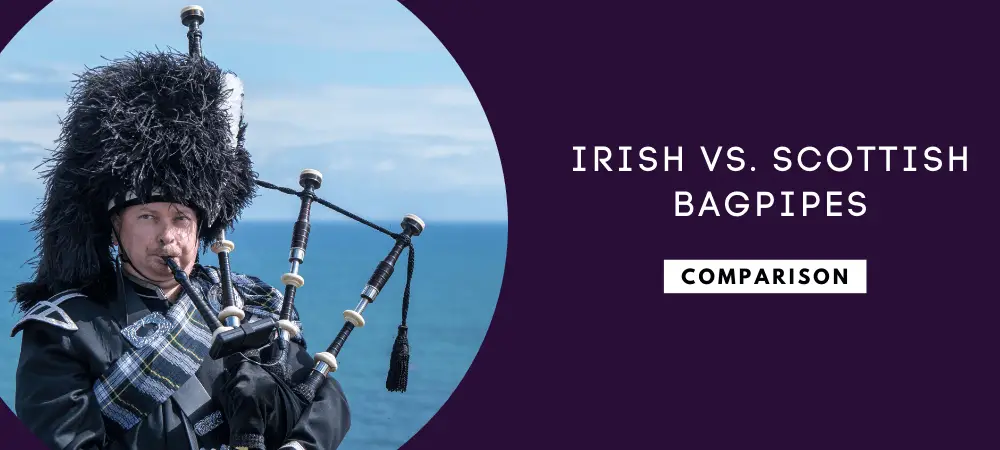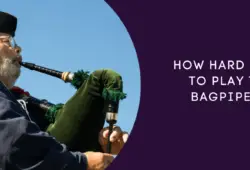Bagpipes are among the most ancient instruments in the world, having a history that’s spans back to the beginnings of civilization.
These instruments have been found across Europe and in many other parts of the world.
Each region appears to have its own type of bagpipe, and it would be virtually impossible to cover all types of bagpipes that there are in the world.
One thing we can do though is taking a look at the two best-known bagpipes which are the Irish bagpipes and the Scottish bagpipes.
Can national boundaries create such distinct differences within a seemingly straightforward musical instrument such as the bagpipe?
Well, let’s find out.
Table of Contents
Table Summary of Comparison Between Irish And Scottish Bagpipes
|
Irish Bagpipes |
Scottish Bagpipes |
|
| Type of Bagpipe |
Uilleann Pipes |
Great Highland Bagpipe |
| Size |
Small and Compact |
Large and Prominent |
| Historical Use |
Social Instrument |
Military Instrument |
| Mode of Inflation |
Bellows-Blown |
Mouth-Blown |
| Tonal Quality |
Soft |
Loud |
| Number of Pipes |
7 |
4 |
| Regulators? |
Yes |
No |
| Chromatic Range |
Two Octaves |
One Octave |
| Playing Posture |
Seated |
Standing or Marching |
| Playing Environment |
Indoors |
Outdoors |
| Musical Styling |
Freestyle and Improvisational |
Formal and Standardized |
What Are Scottish Bagpipes?
Brief History
Whenever anyone talks about bagpipes, they are most likely referring to the Great Highland Bagpipes. These are by far the best-known bagpipes in the world, and they are native to Scotland.
How the bagpipe arrived in Scotland is somewhat of a mystery.
The earliest references to bagpipes in Scotland were in a military context, and this was around 1400. The earliest version of this instrument, however, was nothing like what we see today.
There was possibly just a single drone up until the 1500s when a second one was added. Then it wasn’t until the 1700’s that a third drone appeared, giving us the bagpipe as we now know it.
The Highlanders are credited with developing the pipes into the form it is now, and making it the national instrument of Scotland in peace and war. For this reason, pipers were considered an essential part of society.
As prominent as the bagpipes were in Scotland, did you know that this instrument banned in 1746? This was following the Jacobite uprising of 1745.
Mechanics of The Scottish Bagpipes
The Great Highland Bagpipes consist of a hide bag, a chanter, a blow stick, a bass drone and two tenor drones.
You may see a piper playing these pipes either when they are standing or while marching.
The airtight hide bag is held under the left arm, and the piper blows air through the blow stick and into the bag to inflate it.
The three drones are propped against the player’s shoulder or over the right arm, and the cord joining them helps keep them in an upright position while paying.
The single-reed drones are tuned once before playing, maintain a constant tone throughout the tune.
While the drones produce a constant, unchanging tone, the chanter is the melody pipe on the bagpipes. It has an open-ended design means that players cannot stop it from producing sound once it has started playing.
Well, none of the notes played on the chanter involve closing the bottom hole anyway.
For this reason, music played by the Great Highland Bagpipes does not have rests or pauses in between the melody. It just goes on and on.
The double-reed chanter has eight finger holes capable of producing a fixed scale of 9 notes.
Because the scale is so limited, Scottish pipers need to play more complex ornaments so playing these bagpipes involves a lot of grace notes.
Musicality
On the Great Highland bagpipe, the bass drone and tenor drones are tuned an octave apart, and the bass drone is tuned two octaves below the chanter keynote.
The pitches of the drones are tuned to a tonic note on the chanter called A.
Having only an octave of range, the scale of the Great Highland Bagpipes runs from low A to high A, with there being an extra note – low G (or a 7th), below the low A.
So, the 9-note range of this instrument consists of low G, low A, B, C, D, E, F, high G, and high A.
Here’s where the tricky part comes in though: were you to play the same notes on a piano, you won’t hear a scale resembling the chanter scale.
The reason behind this is because the scale used on these bagpipes is in the Mixolydian mode, i.e., a major scale with a flattened 7th or leading tone.
Were you to replicate this scale on a piano, you’d have to start on G then play all the white keys up to the next G.
The precise frequencies of the notes on a Great Highland bagpipe chanter do not match those of other modern instruments, i.e. the piano or guitar and so these instruments cannot be used to help tune your set of bagpipes.
What Are Irish Bagpipes?
Brief History
The Uilleann pipes are the characteristic national bagpipe of Ireland, and these are considered to be the most elaborate bagpipes in the world.
The Uilleann Pipes emerged in Ireland sometimes around the beginning of the 18th century, and this was around the same time other bellows-blown instruments had appeared in that region.
Such instruments include the Scottish Lowland Bagpipes and the Northumbrian Small pipes, so it’s speculated that they all share a common ancestry.
It wasn’t until the 19th century that the design of the pipes as we know them today came to be.
Before that, the earlier versions of the Uilleann Pipes had two drones, one regulator and a chanter that was played ‘open’. Just as well, these earlier pipes could be played in either a standing or seated position.
The pipes slowly evolved to the design we know today of three drones, three regulators and a chanter that can be played either ‘open’ (legato) or ‘closed’ (staccato).
The elaborate design of Uilleann pipes suggests that their development must have occurred among the well-to-do who are the only ones that could afford such expensive handmade instruments.
These pipes were often used by the protestant clergy who made use of them as an alternative to the church organ. In fact, as recently as the 19th century, the instrument was still popularly associated with the Anglo-Irish.
Mechanics of The Irish Bagpipes
The modern full set of Uilleann Pipes comprises a bag, bellows, a chanter, three drones and three regulators.
These pipes are usually playing indoors, and you will almost always have the piper playing while sitting down as illustrated below:
The hide bag (held under the left arm), is inflated via a tube connected to a small set of bellows strapped around the waist and held under the right arm.
Keep in mind that this setup is for a right-handed player. Left-handed players will have these components set up in reverse.
Using bellows relieves the player from the effort of having to blow to inflate the bag.
Additionally, their use is advantageous in that they allow relatively dry air to power the reeds of the pipes. This, therefore, reduces the adverse effects of moisture on the tuning and longevity of the drone reeds.
The three single-reed drones come from the side of the hide bag and are laid across the player’s knee (hence the need to play while seated).
The drones have a constant background tonic note which accompanies the melody of the chanter.
If the player chooses, the drones can be switched off using a key that’s connected to the stock. The stock is the element which connects the drones to the hide bag.
Regulators are pipes which overlay the drone pipes. This instrument has three regulators, each using a single reed and each having 4 or 5 keys that play notes when pressed with the wrist.
On the Irish bagpipes, the double-reed chanter, which is the melody pipe, has seven finger holes.
The chanter can be played either opened or closed.
To close it, the player simply rests the bottom of the chanter on their thigh, effectively blocking the hole and thereby creating silent gaps between notes.
To do so effectively, it is common to find many players placing a strip of leather over their knee to provide an airtight seal on the bottom hole of the chanter.
Musicality
What distinguishes the Uilleann Pipes apart from many other bagpipes is their tone and wide range of notes.
You have seven pipes (three drones, three regulators and a chanter) uniquely harmonizing to produce a beautiful tune.
You may play the regulators singly or together to create chords that rhythmically and harmonically accompany the chanter’s melody. Some styles of Uilleann piping may favor regulator playing while others don’t even play them at all.
The three drones are the tenor drone, baritone drone and bass drone. The tenor drone is the highest sounding pipe while the bass drone is the lowest sounding pipe on the set.
The three drones are tuned an octave apart and may be switched on or off.
The tenor drone is tuned to the lowest note on the chanter, while the baritone drone is tuned one octave below that. The bass drone is tuned two octaves below the lowest note of the chanter.
The chanter of Uilleann pipes has a range of two full chromatic octaves, and this includes sharps and flats. The second octave has a unique, sweet tone, and this is just part of the defining character of the instrument.
Were you to replicate this scale on a piano, it would be the equivalent of playing all the white and black keys for about 16 notes in a row.
This ability of the Uillean Pipes to play in a typical musical range is what allows pipers to play just about any type of music in this instrument.
Differences Between Scottish And Irish Bagpipes
Availability
Scottish bagpipes are mass-produced, and it is possible to find a good set of pipes for about $1,500.
On the other hand, Irish bagpipes are hand-crafted, and this makes it extremely difficult to get your hands on a set. They are also very expensive, seeing as a decent full set would cost upwards of about $7,000.
Reeds
The dry reeds on Irish bellows-blown bagpipes respond very differently compared to the wet reeds on Scottish mouth-blown bagpipes.
Making the more delicate reeds in Uilleann Pipes is a demanding task which also contributes to the mark up of this instrument. In addition to that, these finicky reeds are immensely difficult to maintain and tune.
You’ll often hear Uilleann pipe reeds being revered to as “the piper’s despair”.
Conversely, Great Highland bagpipe reeds come a dime a dozen. They are less of a headache to deal with, and also far less durable than the reeds found on the Uilleann pipes.
Loudness
The tone of Uilleann pipes is soft and sweet, while that of Highland bagpipes is loud and percussive.
Uilleann pipes are usually no louder than an accordion. They play rather quietly, which is what makes them ideal for indoor playing.
Great Highland bagpipes are very loud, so much that is a piper wishes to play for longer than about 30 minutes, they would have to wear ear protection.
Tone & Range
Irish Uilleann pipes have a range of two full octaves whereas Scottish Great Highland bagpipes have a range of one octave.
To put it simply, Irish bagpipes can play with vowels, but Scottish bagpipes are more congruent with a consonant percussive sound.
You can only get nine notes on a Highland bagpipe, but the Uilleann pipes are capable of achieving many different timbres through a variety of playing techniques, i.e.:
- Playing legato (‘open’ style)
- Playing staccato (‘closed’ style)
- Varying fingering
- Increasing or decreasing bag pressure
Having three drones, three regulators and a chanter whose end can be played closed or opened, Uilleann pipes are a much more elaborate instrument than the highland bagpipes which simply have three drones and an open-end chanter.
Additionally, on Irish bagpipes, keys have been provided to enable the piper to play all the semitones of a given scale accurately.
Another difference comes in whereby the drones on Uilleann pipes can be switched off, but those on Great Highland bagpipes cannot.
You switch them off using a key connected to the stock, thereby allowing the chanter to play by itself.
You have a long meandering ever-present drone in Scottish pipe music, while Irish pipe music comprises clipped, fast repetitive tunes. This is because, with the Irish pipes, it’s possible to have silent gaps between notes.
Uilleann pipes can achieve certain special effects as well, such as the simultaneous vibrato and tremolo, for instance.
Scale & Pitch
The scale of the Great Highland bagpipes is in Mixolydian mode, and the high pitch chanter is set to an A (A4 to be specific).
Uilleann pipes can be pitched in a variety of keys, depending on either the tonic ‘concert D’, or the flat sets in C#, C, B, or B flat. The lower the pitch of the pipes, the quieter and sweeter the resulting tone will be.
The concert pitch is what’s used in most other modern instruments meaning the Irish pipes can be played readily with other instruments while Highland bagpipes cannot because of their tuning.
Playing Experience
A person who plays the Scottish bagpipe is merely a piper. They cannot sing while playing because they need to use their mouths to inflate the bag.
Also, mouth-blowing a bagpipe is quite taxing and would require excellent lung power and lip strength.
Also, playing the Great Highland bagpipe is often associated with outdoor playing with the pipers wearing kilts and marching in a parade.
This isn’t necessarily the case at all times, but still, it’s what comes to mind when often talking about the Scottish bagpipes.
A person who plays the Irish bagpipe player has the luxury of being able to hold a conversation while playing, or they may also choose to sing along to the tune from the pipes.
Moreover, such pipers play sitting down, and so they can go on for hours on end, which is something that cannot be said about Scottish bagpipers.
Uilleann pipers do not wear kilts, and neither do they commonly play in parades. Often, you’ll find them seated in a pub or café simply playing away.
Still, on the playing experience, it is worth noting that the two instruments are taught very differently.
A Scottish bagpipe player has to abide by strict methods, reading sheet music and learning standardized ornamentation techniques.
An Uilleann player, however, learns by ear and can play in a wide variety of styles. Individual players are encouraged to create their own versions of tunes and come up with their own styles of ornamentation.
Lastly, Scottish bagpipes are commonly in groups by bands, and therefore all the pipers present have to play exactly in unison and harmony or else it will sound absolutely horrendous.
This is why they have to read sheet music and memorize tune perfectly.
Irish bagpipes are often played solo and in more relaxed sessions where improvisations and variations are expected.
The full set of Uilleann pipes work similarly to a mini-orchestra that’s complete with drones, melody and chordal accompaniment.
FAQs About Differences Between Irish and Scottish Bagpipes
The Difference Between Bagpipes and Uilleann Pipes
Technically, Uilleann pipes of Ireland are a type of bagpipe. However, they have nothing in common with the Great Highland Bagpipes or Scotland.
There’s a vast difference culturally, musically, and even in the physical appearance of the bagpipes versus that of the Uilleann pipes.
Right from the origin of the two instruments, you have one being predominantly used in war, as a tool of intimidation and inspiration. In contrast, the other was used primarily in the church and laid-back social settings.
The Great Highland bagpipes have a very regimented culture typified by strict methods, structure and standardization.
On the other hand, the Uillean pipes have a more easy-going culture kind of what you’d expect a hippie to be like.
Are Bagpipes Still Banned in Scotland?
No, they are not.
The bagpipes are as central to Scottish culture and identity as Tartan is.
How Many Different Types of Bagpipes Are There?
Possibly hundreds!
Bagpipes are a cultural feature in many countries, and each county has its own variation on the standard bagpipes.
Not only that, but the different countries also know their bagpipes by different names. Each version has its uniqueness exclusive to that particular region of origin.
So, if you were to exhaustively list down all the different types of bagpipes that there are in the world, your list could easily run into the hundreds.
Even then, and there’s a possibility you might still miss out on some pipes seeing as others are now extinct.
Did Bagpipes Originate in Scotland?
No, they did not.
The bagpipes are very much a central part of Scottish culture and identity.
However, long before they appeared in Scotland, these instruments were still found across Europe and in many other parts of the world.
Many historians theorize that the bagpipe originated from Ancient Egypt and was brought to Scotland by Roman Legions.
Do Irish People Play the Bagpipes?
Yes, they do.
The Irish bagpipe hardly looks like the Great Highlands bagpipe and doesn’t sound like it either.
Nevertheless, the Irish people do play the bagpipes, and in fact, the Irish bagpipe is the most complex and elaborate in the world. Irish bagpipes are also distinguished by their tone and wide range of notes.
Conclusion
On the one hand, you have the most well-known bagpipe in the world and on the other, you have the most elaborate bagpipe in the world.
Irish and Scottish bagpipes may be worlds apart, but over the years, each has ended up making their mark in civilization.
The two types of people who play these two instruments are just as contrasting.
While one would be found in a pub, piping away while chugging a beer and singing somewhat out of tune, the other would be found in full kilt regalia marching in a parade.
Which of the two do you think you’d be?




